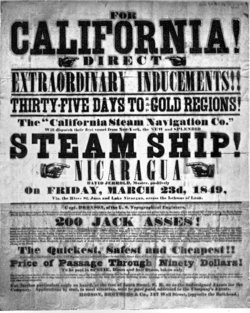Gold rush
|
|
- For the Neil Young album invoking this phrase, see After the Gold Rush.
A gold rush is a period of feverish migration of workers into the area of a dramatic discovery of commercial quantities of gold. In the history of the United States and Canadian, several gold rushes throughout the 19th century, first in the Appalachians, and later in the Sierra Nevada and Rocky Mountains, helped spur permanent population of new regions and define a significant part of the culture of the North American frontier. Similar gold rushes took place during the 19th century in Australia, New Zealand, and South Africa. Gold rushes were typically marked by a general buoyant feeling of a "free for all" in income mobility, in which any single individual might become abundantly wealthy almost instantly. The significance of gold rushes in history have given a longer life to the term, and it is now applied generally to capitalism to denote any economic activity in the participants aspire to race each other in common pursuit of a new and apparently highly lucrative market, often precipitated by an advance in technology.
| Contents |
Life cycle of a gold rush
The discovery of gold in a new region typically began with a spontaneous discovery of "free gold" by a single individual. This free gold was usually placer gold in the beds of streams that descend from a nearby mountain range. Propagation of the news of the discovery typically resulted in a large influx of prospectors to join existing groups and to form new ones. The free gold supply in stream beds would become depleted somewhat quickly, and the initial phase would be followed by a longer a period of prospecting in upper canyon walls for lode gold. Typically the heyday of a gold rush, when the lodes had not yet all been prospected, would last only a few years. In some cases, the depletion of gold was followed by a transition to a silver boom), and then a period of mining of other lesser value minerals. For significant gold-producing areas, the initial rush phase would be followed by a transition to modern industrial mining of ore.
What distinguished gold rushes from gold exploitation campaigns of previous eras was the relative democratization in the participation of mining enterprises. The early New World expeditions of the European colonial powers, notably the Spanish Empire, were driven largely by the search for gold. The expeditions of earlier eras were typical state enterprises, however, and were usually accompanied by state military support. Gold rushes, by comparison, reflected a spontaneous grassroots capitalism akin to homesteading, but centered on mining rather than agriculture. In some places, notably California, the gold rush era is celebrated as embodying an archetypal founding of the state itself.
Factors that led thousands at a time to abandon daily Industrial Revolution drudgery and travel to gold fields (diggings) included
- relative improvements in transport networks;
- improvements in the means of communication that supported rumour-distribution chains,
- some social discontent, and
- an international gold-based monetary system.
Anecdotally, a few miners made fortunes, several suppliers (such as Levi Strauss) and traders made good money, and numerous unfortunates endured hardship and privation in exotic frontiers of civilization for little ultimate reward. Demographically, several gold rushes shook up the patterns of settlement, resulting in the opening up of previously sparsely-settled areas and a Cantonese diaspora around the Pacific Rim. Gold-rush culture, often reflected in popular song, tended to promote self-images of robust masculinity.
Notable gold rushes
- the southern Appalachian Mountains of the U.S., north of Atlanta and west of Charlotte; in Georgia in the late 1830s and North Carolina around 1848;
- California (1848), the California Gold Rush;
- Colorado (1859), the Colorado Gold Rush;
- Australia (1851), the Victorian gold rush;
- Northern Nevada from the 1850s;
- Fraser Canyon to Cariboo (including Barkerville) of British Columbia in 1858-1860, the British Columbia Gold Rush;
- Otago, New Zealand after 1861, the Central Otago goldrush;
- Eastern Oregon in the 1860s and 1870s;
- the Black Hills and other areas in Montana after 1863;
- Transvaal, South Africa (1886), the resulting influx of miners becoming one of the triggers for the Boer War
- the Klondike in Yukon, Canada (1896), the Klondike Gold Rush.
- Alaska (1898)
See also
External Link
- Off to the Klondike! The Search for Gold (http://www.musee-mccord.qc.ca/en/keys/webtours/GE_P2_5_EN.html) — Illustrated Historical Essayde:Goldrausch
es:Fiebre del oro fr:Ruée vers l'or hu:Aranyláz it:Corsa all'oro nl:Goudkoorts pl:gorączka złota zh:淘金潮

